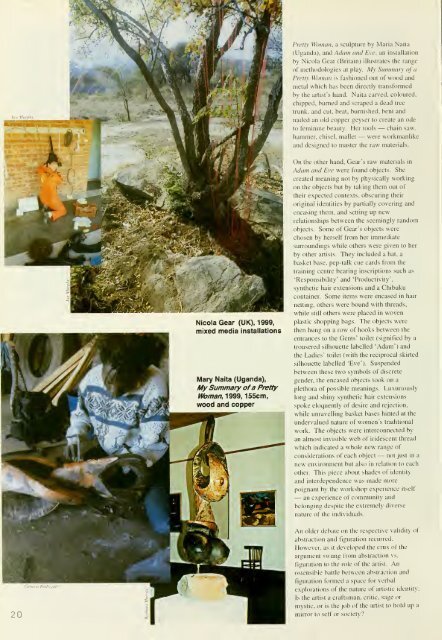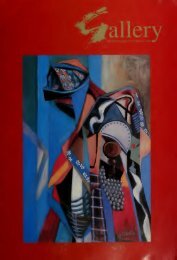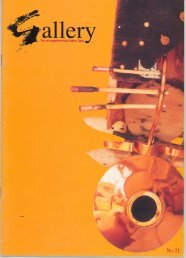Gallery : the art magazine from Gallery Delta
Gallery : the art magazine from Gallery Delta
Gallery : the art magazine from Gallery Delta
Create successful ePaper yourself
Turn your PDF publications into a flip-book with our unique Google optimized e-Paper software.
Nicola Gear (UK), 1999,<br />
mixed media installations<br />
Mary Naita (Uganda),<br />
My Summary ofa Pretty<br />
Woman, 1999, 155cm,<br />
wood and copper<br />
Pretty VJoman. a sculpture by Maria Naita<br />
(Uganda), and Adam and Eve. an installation<br />
by Nicola Gear (Britain) illustrates <strong>the</strong> range<br />
of methodologies at play. My Siimmaiy of a<br />
Pretty Woman is fashioned out of wood and<br />
metal which has been directly transformed<br />
by <strong>the</strong> <strong>art</strong>ist's hand. Naita carved, coloured,<br />
chipped, burned and scraped a dead tree<br />
trunk, and cut. beat, burnished, bent and<br />
nailed an old copper geyser to create an ode<br />
to feminine beauty. Her tools — chain saw.<br />
hammer, chisel, mallet — were workmanlike<br />
and designed to master <strong>the</strong> raw materials.<br />
On <strong>the</strong> o<strong>the</strong>r hand, Gear's raw materials in<br />
Adam and Eve were found objects. She<br />
created meaning not by physically working<br />
on <strong>the</strong> objects but by taking <strong>the</strong>m out of<br />
<strong>the</strong>ir expected contexts, obscuring <strong>the</strong>ir<br />
original identities by p<strong>art</strong>ially covering and<br />
encasing <strong>the</strong>m, and setting up new<br />
relationships between <strong>the</strong> seemingly random<br />
objects. Some of Gear's objects were<br />
chosen by herself <strong>from</strong> her immediate<br />
surroundings while o<strong>the</strong>rs were given to her<br />
by o<strong>the</strong>r <strong>art</strong>ists. They included a hat. a<br />
basket base, pep-talk cue cards <strong>from</strong> <strong>the</strong><br />
training centre bearing inscriptions such as<br />
'Responsibility' and 'Productivity',<br />
syn<strong>the</strong>tic hair extensions and a Chibuku<br />
container. Some items were encased in hair<br />
netting, o<strong>the</strong>rs were bound with threads,<br />
while still o<strong>the</strong>rs were placed in woven<br />
plastic shopping bags. The objects were<br />
<strong>the</strong>n hung on a row of hooks between <strong>the</strong><br />
entrances to <strong>the</strong> Gents' toilet (signified by a<br />
trousered silhouette labelled 'Adam' )<br />
and<br />
<strong>the</strong> Ladies' toilet (with <strong>the</strong> reciprocal skirted<br />
silhouette labelled 'Eve'). Suspended<br />
between <strong>the</strong>se two symbols of discrete<br />
gender, <strong>the</strong> encased objects took on a<br />
plethora of possible meanings. Luxuriously<br />
long and shiny syn<strong>the</strong>tic hair extensions<br />
spoke eloquently of desire and rejection,<br />
u hile unraNelling basket bases hinted at <strong>the</strong><br />
undervalued nature of women's traditional<br />
work. The objects were interconnected by<br />
an almost invisible web of iridescent thread<br />
which indicated a whole new range of<br />
considerations of each object — not just in a<br />
new environment but also in relation to each<br />
o<strong>the</strong>r. This piece about shades of identity<br />
and interdependence was made more<br />
poignant by <strong>the</strong> workshop experience itself<br />
— an experience of community and<br />
belonging despite <strong>the</strong> extremely diverse<br />
nature of <strong>the</strong> mdniduals.<br />
An older debate on <strong>the</strong> respective validity of<br />
abstraction and figuration recuncd.<br />
However, as it de\eloped <strong>the</strong> crux of <strong>the</strong><br />
argument swung Irom abstraction \s.<br />
figuration to <strong>the</strong> role of <strong>the</strong> <strong>art</strong>ist. An<br />
ostensible battle between abstraction and<br />
figuration formed a space for verbal<br />
cvplorations of <strong>the</strong> nature of <strong>art</strong>istic identity:<br />
Is <strong>the</strong> <strong>art</strong>ist a cialtsman. critic, sage or<br />
mystic, or is <strong>the</strong> job of <strong>the</strong> <strong>art</strong>ist to hold up a<br />
mirror to self or society'.'







